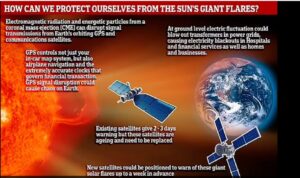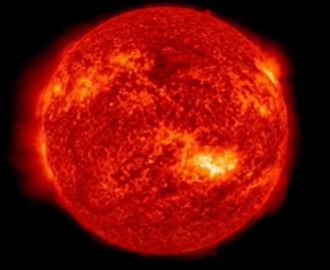For the first time in 19 years, a severe (G4) Geomagnetic storm watch has been issued for several plumes of solar material about to slam into the Earth, and the aurora borealis might appear in Arizona. Experts suggest emergency protocol just incase.
These five or more coronal mass ejections (CMEs) were spat out by a huge and extremely hyperactive sunspot called AR3664 and are due to crash into our atmosphere between May 10 and May 11.
The large sunspot cluster has produced several moderate to strong solar flares since Wednesday at 5:00 am ET. At least five flares were associated with CMEs that appear to be Earth-directed. Space Weather Prediction Center (SWPC) forecasters will monitor NOAA and NASA’s space assets for the onset of a geomagnetic storm.
The last time NOAA announced a Severe (G4) Geomagnetic Storm Watch was in January 2005.
“We have a very rare event on our hands,” Shawn Dall, Noaa’s senior space weather specialist, told press at the Friday briefing.
Severe Storm Watch
NOAA’s Space Weather Prediction Center (SWPC) — a division of the National Weather Service — is monitoring the sun following a series of solar flares and coronal mass ejections (CMEs) that began on May 8. Space weather forecasters have issued a Severe (G4) Geomagnetic Storm Watch for the evening of Friday, May 10. Additional solar eruptions could cause geomagnetic storm conditions to persist through the weekend.
Update: The Storm Watch has been elevated to Storm Warning.
CMEs are explosions of plasma and magnetic fields from the sun’s corona. They cause geomagnetic storms when they are directed at Earth. Geomagnetic storms can impact infrastructure in near-Earth orbit and on Earth’s surface, potentially disrupting communications, the electric power grid, navigation, radio and satellite operations. SWPC has notified the operators of these systems so they can take protective action. Geomagnetic storms can also trigger spectacular displays of aurora on Earth. A severe geomagnetic storm includes the potential for aurora to be seen as far south as Alabama and Northern California.
If these CMEs hit the Earth, they can trigger geomagnetic storms in our magnetosphere.
Geomagnetic storms are classed on a scale of G1 (minor) to G5 (extreme), with G4 storms being considered “severe.” There are around 100 G4 storms per 11-year solar cycle, however, only three have been observed since the beginning of the current solar cycle in December 2019. The most recent was seen on March 23.
What makes this event different is the impact area, the strength, and the fact that there are multiple flares.
Check out www.spaceweather.gov for more information.
Possible views of the aurora borealis in Arizona
Views of the aurora borealis are possible on May 10 in Arizona. Look to the northwest and if its really strong you could see some green aurora on the horizon. If its not as strong you could see a red aurora.
Suggested Protocol
Expects say the potential is high for damage to items connected to the grid. Experts advise to unplug electronic devices tonight, disconnect antennas from two way radios, make sure phones are charged and not plugged in tonight. If you have emergency back up battery packs, charge them today (May 10), and disconnect by tonight or late this evening.

Brent Gordon, the head of the space weather prediction service, said the solar event would last at least through Sunday.

